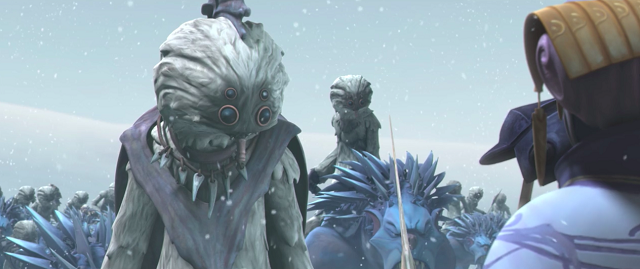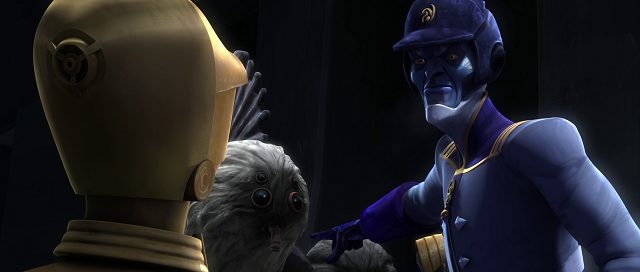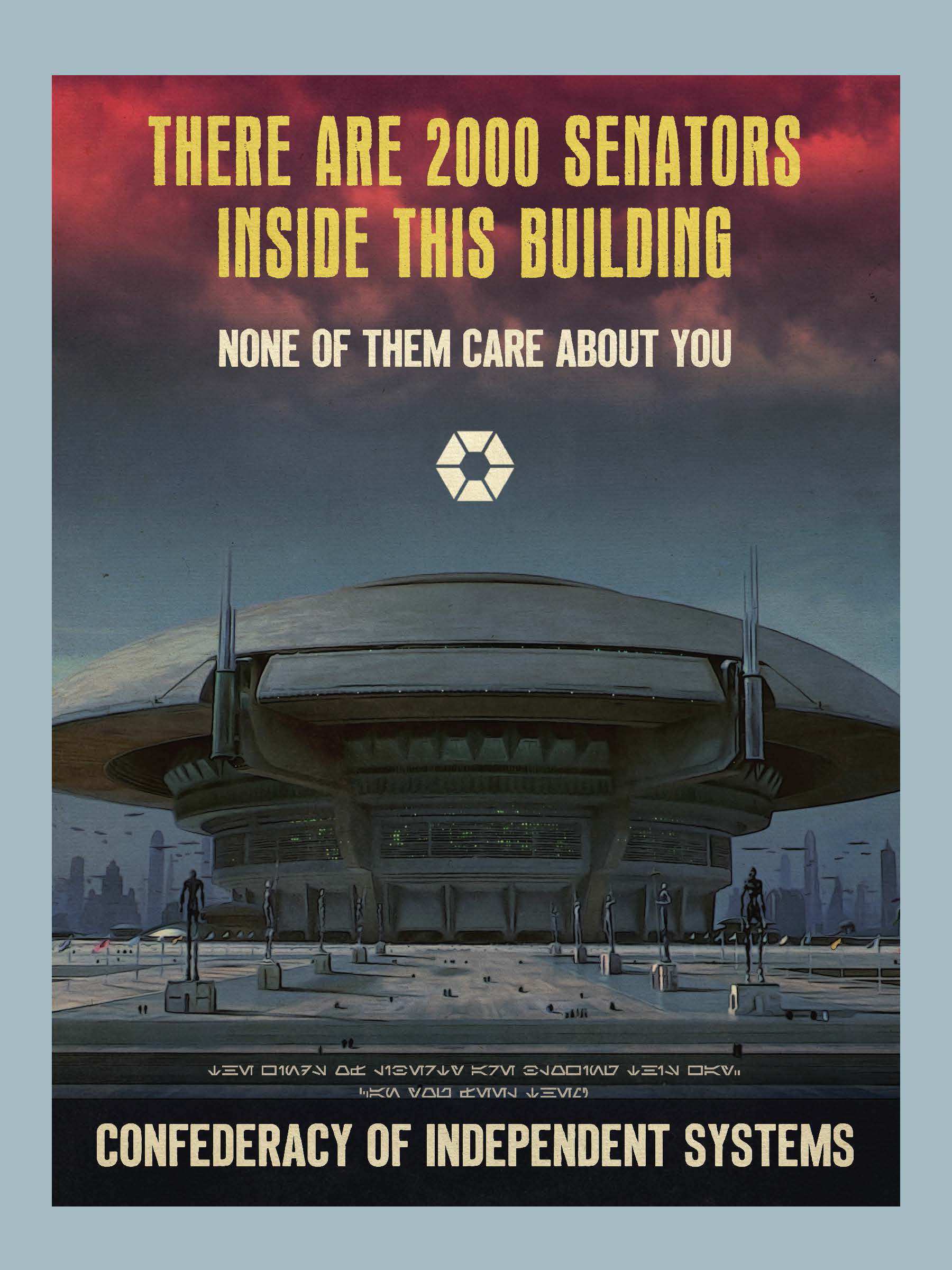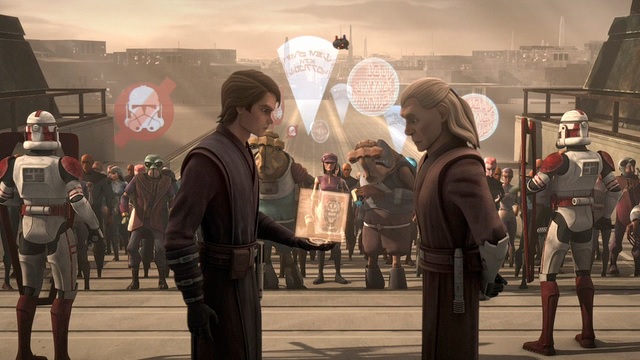
Throughout discussions of The Clone Wars, little has been explored surrounding the intersections of race and class. In this piece, I will show how The Clone Wars includes the narratives of those affected by social injustice, and why it’s important to tell the stories of those who are the least visible. While the show delves into the disastrous repercussions of escalating militarization and war, and the political machinations constantly at play, it also centers many of the underrepresented communities that are most directly impacted.
We see that in the season one episode “Trespass” surrounding the Talz, an alien indigenous community who are caught in the middle of the imperialism and hyper-nationalism of Pantoran leader Chairman Cho. The Chairman presents a “clash of civilizations” between Pantora, the Republic, and the Talz, calling for genocide and an “extermination” of the indigenous race, leading to needless violence and death. Cho declares that the Pantorans have a sovereign right to Orto Plutonia, and the Talz must either submit to their rule or be entirely erased as a population.
In “Trespass”, it’s clear how this is part of a larger process of alien groups being cast and constructed as the racialized Other. Not only does Cho describe the Talz as inherently barbaric “savages” who are “little more than animals”, Anakin also echoes these sentiments, referring to the highly intelligent species as “things”. Indeed, the episode shows that the real costs that come with war are not just lives lost in senseless violence, but also barriers standing in the way of agency and social justice for the universe’s most marginalized communities.

Entrenched in the imagination of the Republic’s institutions and leadership as the Other, The Clone Wars illustrates that the underworld is also vulnerable to the same characteristics assigned to the Talz. Legacies of racialization, colonialism, and imperialism have dehumanized and demarcated nonhuman races as not being worthy of value. Look no further than the positions of power we observe within the Republic’s political and military leadership, dominated by white, human men. It’s also important to note that human Republic military leaders featured in the show, such as Admirals Yularen and Kilian, are often represented as heroic, patriotic, noble, and fighting for a righteous cause, while alien CIS officers like Admiral Trench, Riff Tamson, and Osi Sobeck are regularly constructed as pariahs, known for their manipulation, cunning, and ruthlessness. This associates deeply-embedded negative tropes with alien characters, time and time again portrayed as the racial Other.
Another perspective is shared, however, when the Separatists’ civilian Parliament is first presented in The Clone Wars, contrastingly portrayed as being almost entirely made up of diverse alien races. In “Heroes on Both Sides”, one representative makes it clear that they disembarked from the Republic due to its corruption, democratic failures, and corporate control. As a result, Star Wars fans finally become exposed to a new and justified point of view from a coalition of alien communities that felt victimized and unheard by the Republic, striving for recognition, independence, and self-determination.

The poor material conditions of underrepresented communities on Coruscant are also presented in TCW. The escalation of the war, compounded with increasing wealth and income inequality in the Republic, is shown to have devastated these communities by leaving them without basic government support.
In season three episode “Pursuit of Peace”, Senator Padmé Amidala addresses the Senate to argue against a bill that would stop escalation of the war, particularly through halting the production of clone soldiers. She centers the voice of her aide Teckla, who comes from a working-class district on Coruscant directly impacted by the costs of militarization and economic violence. Padmé explains how Teckla’s family lives with little electricity or running water to bathe her kids. The driving point of the speech is that in pursuit of “safety and security”, the Republic has abdicated its responsibility to provide even the bare necessities for its citizens to survive. It’s easy to draw a comparison to the United States, where an estimated 43% of Americans cannot afford basic living expenses and the military budget approaches one trillion dollars, while some outspoken progressive politicians have questioned where our society’s priorities lie.
Working class and indigent immigrants who come to the Republic’s capital expecting a better future for themselves and their families are segregated into the subterranean realms of the planet. Their perpetual extreme poverty, without basic living needs being met, is shown to foment disorder throughout the underworld, driving constant surveillance and policing. As a result, they have become subjugated along racial and class lines, cast as being innately prone to criminality and violence, and thus targets of incarceration.
In turn, these conditions lead to almost complete disassociation from the mechanisms of Republic society, such as the political process or the Jedi Order. In fact, The Clone Wars indicates that it is only when the Jedi have intel to pursue a criminal investigation that they will involve themselves in this underworld. In the season two episode “Lethal Crackdown”, Padawan Ahsoka and Jedi Master Plo Koon descend into the underlevels in search of rogue bounty hunter Boba Fett. The two enter a club, where Plo Koon asks the bartender for information regarding the whereabouts of Fett. At first the bartender doesn’t comply, shifting his attention back to the bar’s customers. Plo Koon proceeds to unveil his lightsaber and sets it down on the bar table, disclosing his Jedi identity and authority. In response, the underworld citizen observes that it has “been a while since we had one of you down here. Aren’t you a bit busy with your war to be bothering with the likes of us?” Plo Koon retorts sarcastically: “we [the Jedi] are never too busy for the citizens of the Republic…”
Indeed, this dialogue between the Jedi Master and bartender indicates the fractured relationship between the Jedi Order and the people of the underworld, who have become effectively invisible in the midst of the war. The next scene shows Ahsoka focusing intently and listening to other conversations in the room, hoping to hear a lead on Fett’s location. She first hears another alien in the bar, who is in a conversation with another complaining that “this war is killing me”—his business has gone under, and he cries out for another round of drinks to cope.
Instead of dealing with the systematic injustices that the audience sees in the underworld, the Jedi, who are supposed to be paragons of social justice and virtue, are preoccupied with doing whatever is necessary to win the war. This scene can be read in a way that interrogates the legitimacy of the Jedi in the role they are taking. How can they be considered protectors of peace and dignity if they are in fact escalating this war, serving as elite military generals only concerned with their own interests, failing to involve themselves in resolving the very real issues that exist below Coruscant’s luxurious skyscrapers?

In addition to economic disparities created by the war, residents of the underworld are vulnerable to horrific environmental conditions, forced to breath toxic fumes produced on the surface of the city’s industrial sector. In another season two episode, “Lightsaber Lost”, the plot begins as Anakin and Ahsoka are sent to what are described as “treacherous gangster havens” to search for a black market arms dealer. In the dark imagery of the underworld, the episode evokes a community that is criminal, dirty, and overwhelmed with pollution and waste. As Ahsoka walks with Anakin, she passes a Quarren resident on the street repeatedly coughing due to sickness. Ahsoka grimaces, but it’s clear that this is the reality of many of the underworld’s citizens, particularly for those who are working class and nonhuman.
As The Clone Wars is revisited by Lucasfilm this coming year, it must strive to continue including the perspectives, experiences, and stories of characters that are on the receiving end of systems of oppression and domination. The series compellingly brings to light the plight of those who are the most vulnerable to empire, racism, militarism, and capitalism in the Star Wars universe, and we as fans should consider a social justice framework that incorporates these themes in our conversations.
Not only can these tools be useful in our exploration of the Star Wars universe, but they also draw parallels that help us to understand pressing issues within our own society—namely the struggles of those without a living wage and healthcare, or the victims of drone strikes, imperial wars, white supremacy, or forced displacement throughout the world. Being conscious of narratives that include those with marginalized identities allows us to conceptualize the structural violence that reinforces injustice inflicted on the most powerless. Through the centering of these stories, subjugated communities can speak for themselves, giving us a genuine understanding of the struggles they face. As a result, The Clone Wars has been and can continue to be a valuable medium to include these voices, and help us imagine a more socially just future.

Another important element of The Clone Wars is the knowledge that the “good guys” slide into fascism and become the villains of the next trilogy. The “heroic, patriotic, noble, and fighting for a righteous cause” Yularen comes off a lot differently when you remember that he will eventually become a fascist spymaster and be killed on the Death Star. Even when the series engages in more jingoistic-ish imagery or storytelling, the franchise always has that little reminder of the path to which such things can lead.
In general, the major arcs of Star Wars can be interpreted as a giant First World/Third World conflict between the mostly-human Core Worlds and much more diverse Outer Rim. Clone Wars is many of the outer territories seceding to escape the economic and political oppression of the Core. When that fails, you get the Empire, which is substantially more humanocentric and Core-focused than the Republic was, strip-mining planets and enslaving whole non-human species for the de facto economic benefit of the Core (via Star Destroyer contracts, for example). Though two of the Rebellion’s key leaders (Leia and Mothma) are from the Core, much of their support is not. When they finally overthrow the Empire and establish a new galactic democracy, the outer territories and nonhumans regain representation… but many of the Core Worlds, upset at this loss of fortune, eventually fund the First Order, whose purpose is, effectively, to reestablish Core/human dominion over the galaxy. And so the cycle continues…
Funny you should frame it that way, I’m working on another piece that dives directly into that human angle!